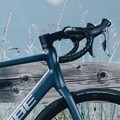The benefits of training and racing with ovalised chainrings.
Until Rotor first burst onto the scene, my entire riding life was under the naivety that the bicycle consisted of round objects. Round wheels, round tubing and round inner tubes to name a few, but asymmetric chainrings? I know the cycling industry is full of innovative products that promise performance benefits, but why reinvent the wheel?

Well, as I write this, I’m sat opposite Dan Duguid, the Brand Manager of Saddleback - Rotor’s UK distributor, as he explains all the benefits of riding ovalised chainrings and how the entire Rotor range has been engineered to the highest standard, including their new, revolutionary 2INpower dual-sided power meter.
"Enhance your legs’ natural strength and reduce their weaknesses."

“Enhance your legs’ natural strength and reduce their weaknesses,” is the promise and the science doesn’t lie. Graph upon graph, case study upon case study and neverending results are being presented and I’m starting to buy into the whole idea.
To put it in perspective, elite-level cyclists saw a 1.6 second advantage in a one kilometre TT study, saving 27 watts. For comparison, 60mm deep aero wheels often claim 1.5-1.8 sec/km and a saving of 16 watts.

To understand the Q-Ring concept, we need to understand how we generate power. We don’t continuously push through the pedals and the majority of us spin our legs in a piston-like motion, just pushing down and waiting for our leg to rotate around the chainring. We may think this is efficient as it gives our legs a little rest on those long, testing climbs but it isn’t.
"Rotor’s Q-Ring products are ovalised to reduce this dead spot and increase the power zone."
When we pedal on a standard chainring, our muscles have a power zone and a dead spot. The power zone is the area we exert the most power due to its angle and the dead spot is where the weakest muscles are used. Dan explains that Rotor’s Q-Ring products are ovalised to reduce this dead spot and increase the power zone.
“The ovalised chainring engages the strongest muscles, so on a 52T chainring you’re pushing the equivalent of a 54T on the strongest angle, and on the weakest, it reduces to an equivalent of 50T,” Dan explains. Simply put, The Rotor Q-Rings reduce the time you spend in the dead spot, increases the time in the power zone and promotes smoother pedalling instead of a piston-like motion.

Full-customisation is another huge benefit that Rotor has taken on board. With their Optimum Chainring Positions (OCP), combined with the Optimum Chainring Angle (OCA), any rider can get the precise chainring angle for their style of riding. “There are five OCPs, but an extra five OCA’s within each OCP."
"...Q-Rings are ideal for riders who suffer from poor knee health and strain."
Dan explains that “It’s not just the performance benefits which attract riders to Rotor (Q-Rings) though, they're also beneficial for riders with injuries, too.” Standard chainrings present great strain on your knees through the dead spot, as your weakest muscles are engaged and copious amounts of pressure can add stress to your knees. So the Q-Rings are ideal for riders who suffer from poor knee health and strain.
So far, I’m impressed. Not only have Rotor developed a product that the cycling industry has never succeeded in before but there’s viable data to prove these chainrings do make a difference to both performance and the reduction of injuries.
“Sounds great, but I’m guessing it’s all made in some far-flung land where you send out the blueprints and it’s shipped back six months later on a huge container, right?” I mutter across the table. “Surely a product in such high demand is mass produced to save costs?” Is this the piece de resistance that puts Rotor ahead of its competition? It turns out, it really is as their chainrings are entirely designed, manufactured and tested at their factory on the outskirts of Madrid, Spain.

“Rotor’s quality control department is unbelievably in-depth. Finding a problem with a Rotor product is like finding a needle in a haystack,” explains Dan, once again exuding his confidence in the brand. With a production line minimum of ten orders, if you’ve got a very specific chainring requirement, chances are you can probably get it from Rotor.
In conclusion, if you're looking to eek out every last performance advantage over the competition or you suffer from persistent knee injuries then Q-rings should be at the top of your kit list. Their ability to reduce strain whilst maximising your power through the dead-spot will enable you to race or train efficiently and safely.







